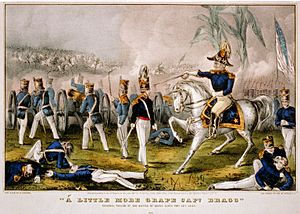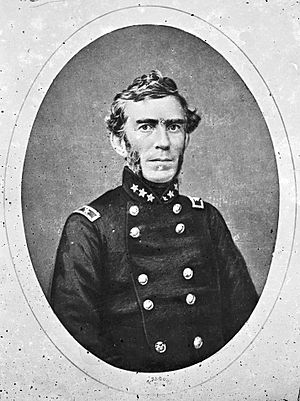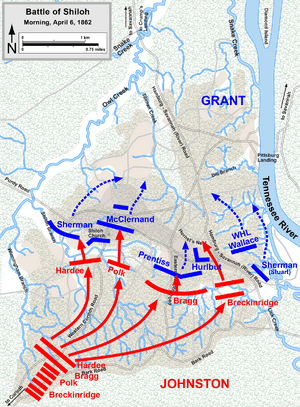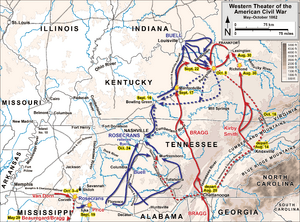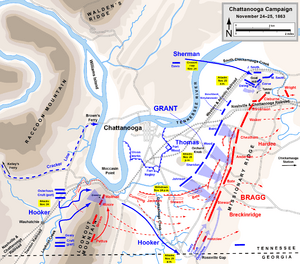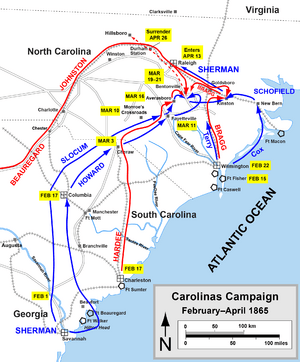Braxton Bragg facts for kids
Quick facts for kids
General
Braxton Bragg
|
|
|---|---|
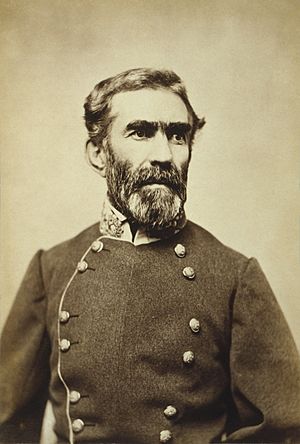
Portrait of Braxton Bragg
|
|
| Born | March 22, 1817 Warrenton, North Carolina |
| Died | September 27, 1876 (aged 59) Galveston, Texas |
| Buried |
Magnolia Cemetery,
(30°40′30.3″N 88°03′45.7″W / 30.675083°N 88.062694°W)Mobile, Alabama |
| Allegiance | |
| Service/ |
United States Army Confederate States Army |
| Years of service | 1837–1856 (USA) 1861–1865 (CSA) |
| Rank | Brevet Lieutenant-Colonel (USA) General (CSA) |
| Commands held | Army of Mississippi (1862) Army of Tennessee (1863) |
| Battles/wars | Second Seminole War |
| Signature | |
Braxton Bragg (March 22, 1817 – September 27, 1876) was an important general in the Confederate States Army during the American Civil War. He was born in Warrenton, North Carolina. He served as a military advisor to Confederate President Jefferson Davis and also led a major army in the Western part of the war.
Bragg studied at West Point, a famous military school. He became an artillery officer, meaning he commanded cannons. He fought bravely in the Mexican–American War, earning several promotions. He was known for being very strict and following rules exactly. After leaving the U.S. Army in 1856, he became a sugar plantation owner in Louisiana, where he used the labor of enslaved people.
When the Civil War began, Bragg helped train soldiers. He led troops at the Battle of Shiloh and later became the commander of the Army of Mississippi, which was later called the Army of Tennessee. He led his army in several big battles, including Perryville, Stones River, Tullahoma, and Chickamauga. While he won some battles, like Chickamauga, he often had trouble working with his officers.
After a major defeat at the Battles for Chattanooga, Bragg was called to Richmond, Virginia, to advise President Davis. Near the end of the war, he helped defend Wilmington, North Carolina. After the war, he worked as an engineer and supervisor in different cities. Many historians consider him one of the less successful generals of the Civil War.
Contents
Early Life and Education
Braxton Bragg was born in Warrenton, North Carolina, on March 22, 1817. He was one of six sons. His older brother, Thomas Bragg, later became the Confederate Attorney General. Braxton's father, Thomas Bragg, was a carpenter who became wealthy. He made sure Braxton could attend the Warrenton Male Academy, a good school.
When Braxton was ten, his father decided he should have a military career. He worked to get Braxton a spot at the West Point. Braxton entered West Point at age 16. He was a good student, especially because he had an excellent memory. He graduated fifth in his class in 1837 and became a second lieutenant.
Military Service
Early Army Career
Bragg's first assignment was in Florida during the Second Seminole War. He didn't see much fighting but suffered from illnesses due to the climate. He was known for being a very strict officer who followed rules precisely. There's a famous story about him, possibly not true, where he was both the company commander and the supply officer. He would ask for supplies as the commander, then deny his own request as the supply officer! He even argued with himself.
His strictness sometimes caused problems. It's said that some of his own soldiers tried to hurt him twice in 1847. In one incident, a cannon shell exploded under his bed, but he was not injured.
In 1843, Bragg was stationed in Charleston, South Carolina. Here, he became friends with three future Union generals: George H. Thomas, John F. Reynolds, and William T. Sherman. Bragg also wrote articles criticizing senior Army leaders, including General Winfield Scott. This led to him being arrested and court-martialed for disobeying orders. He was found guilty but received a light punishment.
Mexican-American War Hero
In 1845, Bragg and his artillery company were sent to Texas to defend against Mexico. He showed great bravery and skill in the Mexican–American War. He earned promotions for his actions at the Battle of Fort Brown, the Battle of Monterrey, and especially the Battle of Buena Vista.
At Buena Vista, his quick thinking with artillery helped stop a larger Mexican attack. He also fought alongside Colonel Jefferson Davis, who would later become the Confederate President. This battle made Bragg a national hero. A military outpost in California, Fort Bragg, California, was named after him.
On December 31, 1855, Bragg left the Army. He and his wife bought a large sugar plantation in Louisiana. He used about 105 enslaved African people to work on his property. He was a stern manager, but his methods quickly made the plantation profitable. He also became involved in local politics.
American Civil War
Before the Civil War started, Bragg was a colonel in the Louisiana Militia. In January 1861, he led volunteers to take control of the federal arsenal in Baton Rouge, Louisiana. He was made a major general in the state army. On March 7, 1861, he became a brigadier general in the Confederate States Army. He commanded forces in Pensacola, Florida, and Alabama. He was promoted to major general in September 1861 and then to full general in April 1862. He was known for training his soldiers to be very disciplined.
Bragg often suffered from health problems like rheumatism and severe headaches. These issues likely made his difficult personality even worse.
Battle of Shiloh
Bragg commanded a corps (a large group of soldiers) at the Battle of Shiloh on April 6–7, 1862. In this surprise attack, Bragg's troops fought hard against a strong Union position called the Hornet's Nest. After General Albert Sidney Johnston was killed, General P. G. T. Beauregard took command and made Bragg his second-in-command. Bragg was upset when Beauregard stopped the attack late on the first day. The next day, the Union army counterattacked, and the Confederates had to retreat.
Despite the retreat, Bragg was praised for his actions. On June 17, 1862, President Davis made him the commander of the Western Department, which included the Army of Mississippi.
Kentucky Campaign and Perryville
In August 1862, Bragg decided to invade Kentucky with his army. He hoped to gain support for the Confederacy there. He moved his 30,000 soldiers by train and road to Chattanooga, Tennessee. Another Confederate general, Edmund Kirby Smith, also invaded Kentucky.
Bragg and Smith planned to combine their armies to defeat the Union forces under General Don Carlos Buell. However, Smith changed the plan and moved north on his own. Bragg captured a Union fort at Munfordville but then decided to join Smith in Frankfort, Kentucky. They even attended the inauguration of a Confederate governor there, but Union cannons interrupted the ceremony.
On October 8, the armies met unexpectedly at the Battle of Perryville. Bragg's troops attacked part of Buell's army and pushed them back. However, Bragg soon realized he had fought only a small part of the Union army. Despite pleas from his officers to keep fighting, Bragg ordered a retreat through the Cumberland Gap. He felt that continuing the fight would risk losing his army. This decision caused many of his officers to complain to President Davis.
Battle of Stones River
Bragg renamed his army the Army of Tennessee in November. In late December, Union General William Rosecrans advanced toward Bragg's position at Murfreesboro, Tennessee. On December 31, 1862, Bragg launched a surprise attack, starting the Battle of Stones River. The Confederates pushed the Union army back, but they couldn't destroy it.
Bragg thought the first day was a victory, but the Union troops stayed put. On January 2, 1863, Bragg ordered another attack, which failed. Facing bad weather and Union reinforcements, Bragg withdrew his army.
After this battle, many of Bragg's generals were very unhappy with his leadership. They complained to President Davis, asking for Bragg to be replaced. General Leonidas Polk, a close friend of Davis, even wrote directly to the president. Davis sent General Joseph E. Johnston to investigate, but Johnston refused to take command himself.
Tullahoma Campaign
Bragg's army fortified its position at Tullahoma, Tennessee. Rosecrans spent six months preparing his army. In June, Rosecrans surprised Bragg by outmaneuvering him. Bragg was slow to react, and his officers were not very cooperative. As the Union army moved around them, Bragg was forced to retreat across the Tennessee River by July 4. This campaign was a success for Rosecrans, who drove Bragg out of Middle Tennessee with few losses.
Bragg's army was joined by more troops, but this also brought more officers who didn't respect him. In September, Bragg was forced to leave Chattanooga, Tennessee, as Union forces moved in.
Battle of Chickamauga
After Rosecrans took Chattanooga, he pursued Bragg into northern Georgia. Bragg's officers continued to cause problems, sometimes ignoring his orders. On September 19–20, 1863, Bragg, with reinforcements, turned and attacked Rosecrans at the Battle of Chickamauga. This was the biggest Confederate victory in the Western Theater.
However, it wasn't a complete victory. Bragg wanted to cut off Rosecrans from Chattanooga and destroy his army. But a strong defense by General George Henry Thomas allowed most of the Union army to escape to Chattanooga.
After the battle, Bragg laid siege to Chattanooga. He continued to argue with his officers, suspending some of them. Many of his generals were frustrated that he didn't follow up on the victory. They secretly asked President Davis to replace Bragg. Even General James Longstreet wrote that only "the hand of God" could help them with Bragg in command. Davis traveled to Chattanooga to try to fix the problem. Although Bragg offered to resign, Davis decided to keep him in command.
Battles for Chattanooga
While Bragg argued with his officers, the Union army in Chattanooga received a new commander, General Ulysses S. Grant, and many reinforcements. The Battles for Chattanooga were Bragg's last as an army commander. On November 24, his left flank fell during the Battle of Lookout Mountain. The next day, in the Battle of Missionary Ridge, his main defensive line was overwhelmed by a frontal attack.
Bragg's army was defeated and retreated. He offered his resignation on November 29, and President Davis accepted it right away. General Joseph E. Johnston took over command of the Army of Tennessee.
Advisor to the President
In February 1864, Bragg was called to Richmond to advise President Davis. He became Davis's military advisor, helping with military operations and improving the army's supply system. He also managed military prisons and hospitals. Bragg had many disagreements with other officials, but he got along well with Robert E. Lee.
In May, Bragg helped defend Richmond and Petersburg. Davis was concerned that Joseph Johnston, who now commanded the Army of Tennessee, was too cautious against General William T. Sherman in the Atlanta Campaign. Davis sent Bragg to Georgia to investigate. Bragg spoke with General John Bell Hood, who wanted to take offensive action. Davis chose Hood to replace Johnston.
Operations in North Carolina
In October 1864, President Davis sent Bragg to command the defenses of Wilmington, North Carolina. This city was important as the last seaport on the Atlantic coast for the Confederacy. Union forces tried to capture Fort Fisher, which protected Wilmington. The Confederates successfully stopped the first attack.
However, when the Union returned in January, Bragg's performance was poor. He thought the fort was safe and didn't send help quickly enough. The Confederates lost Fort Fisher and had to leave Wilmington.
Bragg's military career was ending. Joseph E. Johnston was put back in command of the forces defending against Sherman in North Carolina. Bragg became a corps commander under Johnston. His troops won a small victory at the Second Battle of Kinston and fought at the Battle of Bentonville. After Richmond fell, Bragg met with Jefferson Davis and helped convince him that the war was lost. Bragg was captured and released on May 9, 1865.
Later Life and Death
After the war, Bragg and his wife, Elise, had lost their home. Their plantation had been taken by the Union Army. In 1867, Bragg became the superintendent of the New Orleans waterworks, but he was soon replaced. He worked for an insurance company and as an engineer for the city of Mobile, Alabama. He later moved to Texas and worked as a railroad engineer.
On September 27, 1876, Braxton Bragg suddenly collapsed and died in Galveston, Texas, at age 59. Doctors believed he died from a problem with his brain or heart. He is buried in Magnolia Cemetery in Mobile, Alabama.
Personal Life
Braxton Bragg married Eliza Brooks Ellis, known as Elise, in 1849. She was a wealthy sugar heiress from Thibodaux, Louisiana. They lived in various military posts, including Jefferson Barracks, Missouri, and frontier forts in the Indian Territory. The primitive conditions at these forts were difficult for the couple.
Character
Many historians believe Bragg was not a very good army commander. They point to his simple tactics, like always attacking head-on, and his failure to follow up on victories. His difficult personality, his tendency to blame others, and his poor relationships with his officers also contributed to his problems.
Some historians, like Judith Lee Hallock, argue that blaming Bragg for all Confederate defeats in the West is too simple. They say he was a good organizer. They also point out that bad luck and some of his officers, especially General Polk, were also to blame for defeats. Polk, though brave, was not a great tactician and often disobeyed Bragg's orders.
Legacy
Several places in the United States are named after Braxton Bragg:
Images for kids
See also
 In Spanish: Braxton Bragg para niños
In Spanish: Braxton Bragg para niños


